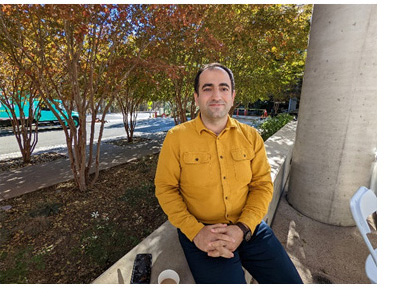The EEGLAB News #15
Seyed Yahya Shirazi, Ph.D.
Postdoctoral Fellow, Swartz Center for Computational Neuroscience (SCCN), UC San Diego
 Seyed Yahya Shirazi, Ph.D., recently completed a Postdoctoral position at New York University (NYU). “My main research has been using Mobile Brain/Body Imaging (MoBI) in the field of clinical rehabilitation. We use EEG to look at what we call corticomuscular connectivity or brain-muscle connections as a biomarker for changes in behavior. For example,” he clarifies, “we measure EEG to determine whether a stroke patient is performing or rehabilitating at the maximum level. Or we use EEG to determine how the elderly are using their muscles during a challenging task.”
Seyed Yahya Shirazi, Ph.D., recently completed a Postdoctoral position at New York University (NYU). “My main research has been using Mobile Brain/Body Imaging (MoBI) in the field of clinical rehabilitation. We use EEG to look at what we call corticomuscular connectivity or brain-muscle connections as a biomarker for changes in behavior. For example,” he clarifies, “we measure EEG to determine whether a stroke patient is performing or rehabilitating at the maximum level. Or we use EEG to determine how the elderly are using their muscles during a challenging task.”
This is a new approach, studying patients in a clinical setting and fine tuning each person’s rehabilitation to fit their specific need. “The idea,” Dr. Shirazi clarifies, “is to use these brain or muscle signals, or the connection between them, as a closed loop rehabilitation. We are measuring real-time brain signal (EEG or the EEG/EMG combined) while the patient is doing the exercise, so that we can modify the exercise in a personalized manner to benefit that one person. Because no stroke is the same. So the rehabilitation shouldn’t be the same, either.”
Working with MoBI in a clinical rehabilitation setting has been challenging. For his Postdoc at NYU, Dr. Shirazi and his team moved their entire set up (EEG, EMG, all MoBI equipment), to the rehabilitation clinic, where they would test patients. Dr. Shirazi admits, “It is a challenge to do that, but it was pretty wonderful and pretty rewarding. It gives the patients hope. We always tell them that this study doesn’t have a direct impact on their improvement. But still, seeing that researchers are working to develop more effective rehabilitation was very rewarding for them. It is super rewarding for us (researchers), as well!”
This project was funded by a joint National Science Foundation (NSF) / U.S. Food and Drug Administration (FDA) effort. “It was promoted to be used as an FDA science toolbox for evaluation of rehabilitation choices,” Dr. Shirazi clarifies, “and later on, as a toolbox for improving rehabilitation methods to be more helpful.”
Dr. Shirazi joined SCCN in December 2022, and will work remotely in New York (possibly moving to San Diego sometime next year). He plans to work as a MoBI researcher at SCCN, first as a Postdoctoral Fellow and then hopefully as a Research Scientist. Like the other workshop attendees, he is a big fan of EEGLAB: “I use EEGLAB on a daily basis, as well as many of the plug-ins, for instance Cleanline, ICLabel, DIPFIT, LIMO, and get_chanlocs,” he shares. “I am also a huge fan of Neuroelectromagnetic Forward Modeling Toolbox (NFT), a MATLAB toolbox for generating realistic head models from available data (MRI and/or electrode locations), and for computing numerical solutions for solving the forward problem of electromagnetic source imaging.”
While it will take time for this individualized MoBI approach to move from research to actual clinical use, Dr. Shirazi remains very optimistic. “I think in the next four to five years, it is going to be something that we can use objectively to determine if a person is improving on a neural level,” he shares, the excitement in his voice palpable. “We will be finding a biomarker of improvement from the neural standpoint. Because a stroke, Parkinson’s Disease, even aging, happens on the neural level. But what we assess is the performance level. How much can you walk? This is neural, damage in the central nervous system (CNS). But how we assess it is from the symptoms. So the idea is to get back to the CNS and try to monitor it, and try to see if we are intervening, helping. Are we using the full potential to recover or not? This approach is very exciting.”
R. Weistrop, March 2023